4-Ethynyl-benzoic acid is widely utilized in research focused on:
- Organic Synthesis: This compound serves as a key intermediate in the synthesis of various organic molecules, particularly in the development of pharmaceuticals and agrochemicals.
- Polymer Chemistry: It is used to modify polymer properties, enhancing thermal stability and mechanical strength, making it valuable in the production of high-performance materials.
- Fluorescent Probes: Researchers employ it in the creation of fluorescent probes for biological imaging, aiding in the visualization of cellular processes.
- Material Science: The compound is utilized in the fabrication of advanced materials, such as conductive polymers, which are essential in electronics and energy storage devices.
- Pharmaceutical Development: It plays a role in the design of novel drug candidates, particularly in targeting specific biological pathways, offering potential advantages over existing therapies.
Información general
Propiedades
Seguridad y normativas
Aplicaciones
4-Ethynyl-benzoic acid is widely utilized in research focused on:
- Organic Synthesis: This compound serves as a key intermediate in the synthesis of various organic molecules, particularly in the development of pharmaceuticals and agrochemicals.
- Polymer Chemistry: It is used to modify polymer properties, enhancing thermal stability and mechanical strength, making it valuable in the production of high-performance materials.
- Fluorescent Probes: Researchers employ it in the creation of fluorescent probes for biological imaging, aiding in the visualization of cellular processes.
- Material Science: The compound is utilized in the fabrication of advanced materials, such as conductive polymers, which are essential in electronics and energy storage devices.
- Pharmaceutical Development: It plays a role in the design of novel drug candidates, particularly in targeting specific biological pathways, offering potential advantages over existing therapies.
Documentos
Hojas de datos de seguridad (HDS)
La SDS proporciona información de seguridad completa sobre la manipulación, el almacenamiento y la eliminación del producto.
Especificación del producto (PS)
La PS proporciona un desglose completo de las propiedades del producto, incluida la composición química, el estado físico, la pureza y los requisitos de almacenamiento. También detalla los rangos de calidad aceptables y las aplicaciones previstas del producto.
Certificados de análisis (COA)
Busque certificados de análisis (COA) ingresando el número de lote del producto. Los números de lote y de partida se pueden encontrar en la etiqueta de un producto después de las palabras "Lote" o "Lote".
Número de catálogo
Número de lote/lote
Certificados de origen (COO)
Este certificado de origen confirma el país en el que se fabricó el producto y también detalla los materiales y componentes utilizados en él y si se deriva de fuentes naturales, sintéticas u otras fuentes específicas. Este certificado puede ser necesario para cumplir con las normativas aduaneras, comerciales y regulatorias.
Número de catálogo
Número de lote/lote
Hojas de datos de seguridad (HDS)
La SDS proporciona información de seguridad completa sobre la manipulación, el almacenamiento y la eliminación del producto.
DownloadEspecificación del producto (PS)
La PS proporciona un desglose completo de las propiedades del producto, incluida la composición química, el estado físico, la pureza y los requisitos de almacenamiento. También detalla los rangos de calidad aceptables y las aplicaciones previstas del producto.
DownloadCertificados de análisis (COA)
Busque certificados de análisis (COA) ingresando el número de lote del producto. Los números de lote y de partida se pueden encontrar en la etiqueta de un producto después de las palabras "Lote" o "Lote".
Número de catálogo
Número de lote/lote
Certificados de origen (COO)
Este certificado de origen confirma el país en el que se fabricó el producto y también detalla los materiales y componentes utilizados en él y si se deriva de fuentes naturales, sintéticas u otras fuentes específicas. Este certificado puede ser necesario para cumplir con las normativas aduaneras, comerciales y regulatorias.


